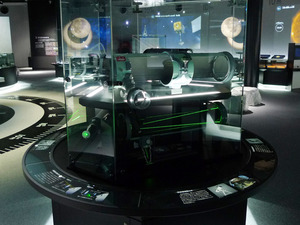Nagoya City Science Museum
TOP > Exhibition Guide > Keyword Search > Starting with "M" > mechanism > Optical Telescope System
Optical Telescope System



Purpose of Exhibition
The light-gathering power of a telescope depends on its diameter. So, a telescope with large diameter allows us to see in detail much darker celestial objects that are extremely faint in naked eye.
There are three main ways for optical telescopes to collect light: REFRACTING TELESCOPES which combine some lenses, REFLECTING TELESCOPES made of a concave mirror instead of lenses, and CATADIOPTRIC TELESCOPES which use a combination of refractor and reflector characteristics, and typically have a corrector plate (a kind of lens) and a concave mirror.
This exhibit will show how optical telescopes work, with cutaway models and laser beams to demonstrate the light path in each type of telescopes.
Additional Knowledge
[Telescope Magnification]
Telescope magnification can be calculated from the following relation:
[Magnification] = [Telescope focal length] ÷ [Eyepiece focal length]
The telescope on the rooftop of the Nagoya City Science Museum, for example, has a focal length of 8,000mm. When a 40mm focal length eyepiece is attached to the telescope, the magnification would be 200x (8,000mm ÷ 40 = 200).
However, having a high telescope magnification doesn't mean that you have clearer images. Too high magnification reduces the brightness and sharpness, and can lead to blurry images. The useful highest magnification is about the same as one’s diameter in millimeters. For instance, the highest magnification of a 6cm diameter telescope is approximately 60x (6cm=60mm). In case of observing bright planets, it could be seen sharp with twice as higher as this magnification. So, this telescope’s maximum practical magnification is up to 120x.
This page was last edited on 15 June 2022.
Article by Astronomy Section
